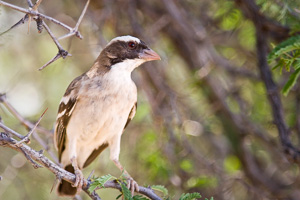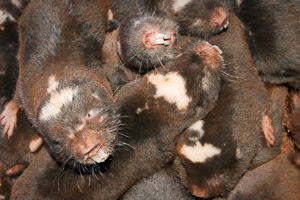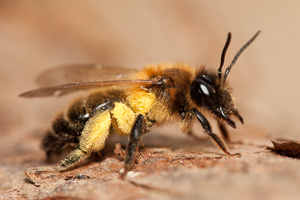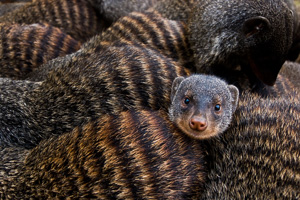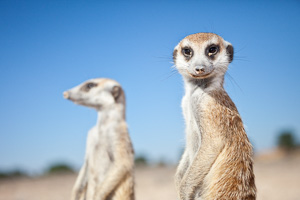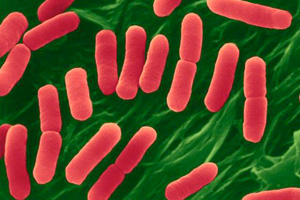Copy of Social Evolution
Social Evolution
THE EVOLUTION OF SOCIALITY AND ITS IMPACT ON LIFE-HISTORIES
Long-term field studies | Comparative analysis | Experimental evolution
The BIG Questions...
Our projects address evolutionary and mechanistic questions about cooperation, conflict and dispersal in animal societies, and their impacts on life-histories.
We do this through a combination of long-term field studies of wild social vertebrates, comparative a across taxa, and experimental evolution work on microbes.
COOPERATION
Why and where have cooperative societies evolved?
By what mechanisms does cooperation yields its benefits?
How and why does cooperation impact life-histories?
And how does ageing impact cooperation?
How do genes and the early life environment influence cooperative tendencies?
Why do the sexes frequently differ in cooperative contributions?
CONFLICT
How is conflict resolved in animal societies?
What traits facilitate winning? How are sexual and kin selection shaping these traits? How do costs entailed in conflict shape patterns of ageing?
What are the causes and consequences of stress in societies?
DISPERSAL
Why have sex differences in dispersal evolved?
What are their evolutionary implications for patterns of cooperation and conflict?
How are extra-territorial prospecting forays used to assess outside options?
Why do age-based queues evolve and what are their evolutionary implications?
Might sociality favour a degree of inbreeding?
And can the social environment mitigate inbreeding depression?
Model Systems:
white-browed sparrow weavers
We have been running a longitudinal field study of this cooperatively breeding bird in the South African Kalahari desert since 2007. We now have >11 years of life-history data for >40 social groups, comprising egg, nestling and provisioning data from >900 breeding attempts, and >1700 individuals monitored throughout their lives to date.
EUROPEAN BADGERS
The Animal Plant and Health Agency (APHA) have been monitoring the lives of all individuals in 40 social groups of European badgers for the past 40 years, with a particular focus on their role in bovine tuberculosis dynamics. This work has yielded an incredible longitudinal data set of life-history, morphology and disease status information on >5000 individuals.
We use this phenomenal model to study the evolution & mechanisms of ageing and their interactions with sociality, in collaboration with APHA.
Cooperative mammals, insects and microbes...
We also use a range of other social organisms as models. My PhD and early fellowship work focussed on conflict and cooperation in meerkat societies, and then I set up a longitudinal field study of Damaraland mole-rats. I am now also engaged in collaborative research on cooperation and conflict in banded mongoose and social insect societies, and have recently begun collaborative experimental evolution work on social microbes.
RELEVANT PUBLICATIONS:
COOPERATION
Sexually selected sentinels? Evidence of a role for intra-sexual competition in sentinel behaviour
Walker, L., York, J.E., Young, A.J. (2016)
Behavioral Ecology
Fundamental problems with the cooperative breeding hypothesis. A reply to Burkart & Van Schaik.
Thornton, A.J., McAuliffe, K., Dall, S.R.X., Fernandez-Duque, E., Garber, P.A., Young, A.J. (2016)
Journal of Zoology
The oxidative costs of reproduction are group-size dependent in a wild cooperative breeder
Cram, D.L., Blount, J.D., Young, A.J. (2015)
Proceedings of the Royal Society B
Workforce effects and the evolution of complex sociality in wild Damaraland mole-rats
Young, A.J., Jarvis, J.U.M., Barnaville, J., Bennett, N.C. (2015)
American Naturalist
Oxidative status and social dominance in a wild cooperative breeder
Cram, D.L., Blount, J.D., Young, A.J. (2015)
Functional Ecology
The origins of consistent individual differences in cooperation in wild banded mongooses
Sanderson, J.L., Stott, I., Young, A.J., Vitikainen, E., Hodge, S.J., Cant, M.A. (2015)
Animal Behaviour
Inclusive fitness theory and eusociality
Abbot et 137 others (2011)
Nature
Morphological divergence of breeders and helpers in wild Damaraland mole-rat societies
Young A.J., & Bennett N.C. (2010)
Evolution
Helpers increase the reproductive potential of offspring in cooperative meerkats
Russell A.F., Young A.J., Spong G., Jordan N.R. & Clutton-Brock T.H. (2007)
Proceedings of the Royal Society B
Cortisol levels are positively associated with pup-feeding rates in male meerkats
Carlson A.A., Manser M.B., Young A.J., Russell A.F., Jordan N., McNeilly A.S. & Clutton-Brock T.H. (2006)
Proceedings of the Royal Society B
Elevated prolactin levels immediately precede decisions to babysit by meerkat helpers
Carlson A.A., Russell A.F., Young A.J., Jordan N., McNeilly A.S. & Clutton-Brock T.H. (2006)
Hormones & Behavior
Trade-offs between extra-territorial prospecting and helping in a cooperative mammal
Young A.J., Carlson A.A. & Clutton-Brock T.H. (2005)
Animal Behaviour
Evolution and development of sex differences in cooperative behavior in meerkats
Clutton-Brock T.H., Russell A.F., Sharpe L.L., Young A.J., Balmforth Z. & McIlrath G.M. (2002)
Science
CONFLICT
Explaining negative kin discrimination in a cooperative mammal society
Thompson, F., Cant, M.A., Marshall, H., Vitikainen, E.I.K., Sanderson, J.L., Nichols, H.J., Gilchrist, J.S., Bell, M.B.V., Young, A.J., Hodge, S.J., Johnstone, R. (2017)
Proceedings of the National Academy of Sciences of the USA
Reproductive competition triggers mass eviction in cooperative banded mongooses
Thompson, F., Marshall, H., Sanderson, J.L., Vitikainen, E.I.K., Nichols, H.J., Gilchrist, J., Young, A.J., Hodge, S.J., Cant, M.A. (2016)
Proceedings of the Royal Society B
Sex differences in senescence: the role of intra-sexual competition in early adulthood
Beirne, C., Delahay, R., Young, A.J. (2015)
Proceedings of the Royal Society B
Elevated glucocorticoid concentrations during gestation predict reduced reproductive success in female banded mongooses
Sanderson, J.L., Nichols, H., Marshall, H.M., Vitikainen, E., Thompson, F., Walker, S., Cant, M.A., Young, A.J. (2015)
Biology Letters
Intra-sexual selection in cooperative mammals and birds: why aren’t females bigger and better armed?
Young, A.J., Bennett, N.C. (2013)
Philosophical Transactions of the Royal Society B
Resolving social conflict among females without overt aggression
Cant, M.A., Young, A.J. (2013)
Philosophical Transactions of the Royal Society B
Complete reproductive skew within white-browed sparrow weaver groups despite outbreeding opportunities for subordinates of both sexes
Harrison, X.A., York, J.E., Cram, D.L., Hares, M.J., Young, A.J. (2013)
Behavioral Ecology and Sociobiology
Reproductive status and testosterone among females in cooperative mole-rat societies
Lutermann H., Young A.J., Bennett N.C. (2013)
General and Comparative Endocrinology
Individual contributions to territory defence in a cooperative breeder: weighing up the benefits and costs
Mares R., Young A.J., Clutton-Brock T.H. (2012)
Proceedings of the Royal Society B
Adaptive suppression of subordinate reproduction in cooperative mammals
Clutton-Brock T.H., Hodge, S.J., Flower, T.P., Spong, G., Young, A.J. (2010)
American Naturalist
Physiological suppression eases in Damaraland mole-rat societies when ecological constraints on dispersal are relaxed
Young A.J., Oosthuizen M.K., Lutermann H. & Bennett N.C. (2010)
Hormones & Behavior
The Causes of Physiological Suppression in Vertebrate Societies: a Synthesis
In edited volume: "Reproductive skew in vertebrate societies: proximate and ultimate causes"
Young A.J. (2009)
Physiological suppression among female meerkats: a role for subordinate restraint due to the threat of infanticide?
Young A.J., Monfort S.L. & Clutton-Brock T.H. (2008)
Hormones & Behavior
Factors affecting the reproductive success of dominant male meerkats
Spong G., Hodge S.J., Young A.J. & Clutton-Brock T.H. (2008)
Molecular Ecology
Stress and the suppression of subordinate reproduction in cooperatively breeding meerkats
Young A.J., Carlson A.A., Monfort S.L., Russell A.F., Bennett N.C. & Clutton-Brock T.H. (2006)
Proceeding of the National Academy of Sciences of the USA
Infanticide by subordinates influences reproductive sharing in cooperatively breeding meerkats
Young A.J. & Clutton-Brock T.H. (2006)
Biology Letters
Dispersal, Eviction and Conflict in Meerkats (Suricata suricatta): An ESS Model
Stephens P.A., Russell A.F., Young A.J., Clutton-Brock T.H. & Sutherland W.J. (2005)
American Naturalist
Hormonal correlates of dominance in cooperative meerkats (Suricata suricatta)
Carlson A.A., Young A.J., Russell A.F., Bennett N.C, McNeilly A.S. & Clutton-Brock T.H. (2004)
Hormones & Behavior
DISPERSAL
Population genetic structure and direct observations reveal sex-reversed patterns of dispersal in a cooperative bird
Harrison, X.A., York, J.E., Young, A.J. (2014)
Molecular Ecology
Timing of pre-dispersal prospecting is influenced by environmental, social and state-dependent factors in meerkats
Mares, R., Bateman, A.W., English, S., Clutton-Brock, T.H., Young, A.J. (2014)
Animal Behaviour
Extra-group mating increases inbreeding risk in a cooperatively breeding bird
Harrison, X.A., York, J.E., Cram, D.L., Young, A.J. (2013)
Molecular Ecology
Responses to intruder scents in the cooperatively breeding meerkat: sex and social status differences
Mares R., Young A.J., Levesque D., Harrison N., Clutton-Brock T.H. (2011)
Behavioral Ecology
Stress and the costs of extra-territorial prospecting in a social mammal
Young A.J. & Monfort S.L. (2009)
Biology Letters
Subordinate male meerkats prospect for extra-group paternity: alternative reproductive tactics in a cooperative mammal
Young A.J., Spong G. & Clutton-Brock T.H. (2007)
Proceedings of the Royal Society B
Dispersal, Eviction and Conflict in Meerkats (Suricata suricatta): An ESS Model
Stephens P.A., Russell A.F., Young A.J., Clutton-Brock T.H. & Sutherland W.J. (2005)
American Naturalist
Trade-offs between extra-territorial prospecting and helping in a cooperative mammal
Young A.J., Carlson A.A. & Clutton-Brock T.H. (2005)
Animal Behaviour

